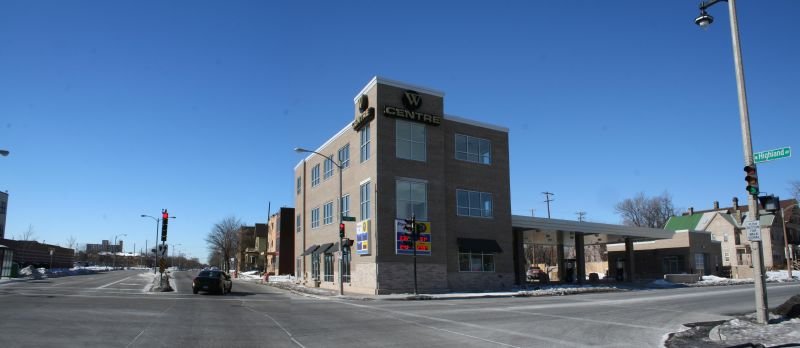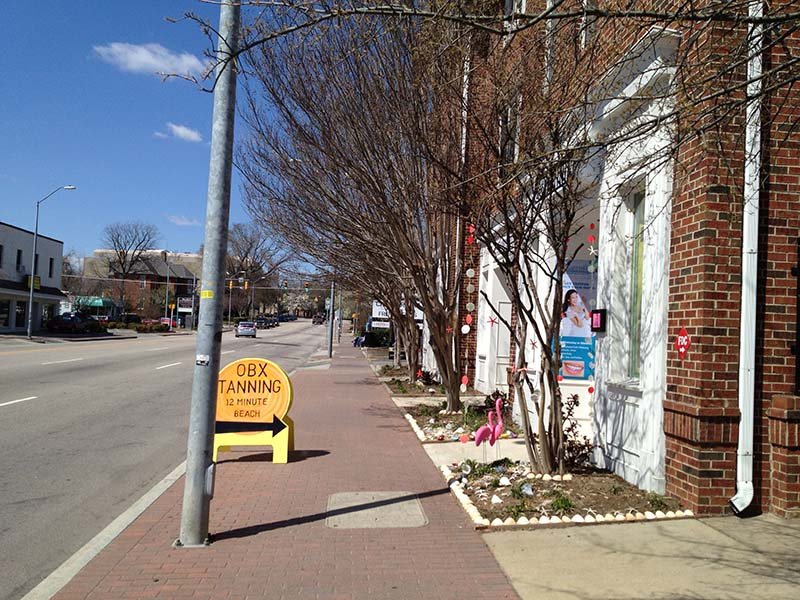Best of Blog: Good Enough Urbanism
Andrew Burleson is one of those guys who sees the world without a filter. There are very few people I've ever met who are able to look at a situation, analyze it in a blink and come up with credible solutions the way Andrew does. And on top of that, he's just a fantastic communicator. We're very fortunate to have him writing for us on a regular basis.
This year Andrew joined me on our Curbside Chat tour in Idaho. Between him and John Reuter, there was never a dull moment. (John's on the left of me in this photo, Andrew on the right).
This post of Andrew's on "good enough" urbanism is a perfect representation of his thinking. Unorthodox yet very pragmatic and logical. Stay tuned to Strong Towns in 2014 for much more from Andrew Burleson.
---
Good Enough Urbanism by Andrew Burleson
Over the years I've found something I think people who love walkable, human-oriented places collectively struggle with: we want to get the *very best* urban design codified and implemented in our cities. This is of course the right end-goal, but it hurts us by limiting our ability to productively deal with overwhelming quantity of low-quality, underperforming space in the city.
There are two main reasons why.
#1. Assuming we're not just abandoning the auto-oriented places for new, "better" greenfields, we're dealing with places that are already built - and built *terribly.* To move these places from terrible to great means basically leveling it and starting over: new buildings, reconfigured infrastructure, everything. Starting over is much more expensive than patching something, and in the new economy that means it will often be infeasible.
#2. The details are so important for great urban design, and it's politically very difficult to get all the details accounted for if you're using code to bring place-making to a city that doesn't already have a culture of it.
This second point is really important, so here's my first example. I found this picture online of a new gas station in an urban area in Milwaukee:
At first glance, this seems like a nice, street-fronting building. It's hiding a gas station in the back, which is pretty great because gas stations are the kind of thing you need to have around, but you don't really want to look at. Look closely, though, and we can see some major problems. The streets here are too big, the public realm is too small and is relatively uninviting.
Yet in many ways this is what we're getting when we overhaul a city's codes. We want the building close to the street- we want doors and windows onto the street, and we want decent materials etc. facing the public. The building above meets those minimum requirements. But, ouch, how hostile of a place it remains.
I think the picture above perfectly represents what happens when we win a battle and get a "Smart" or otherwise better code adopted in an existing area. The culture of walking isn't there, so the buildings reflect a reluctant compliance to the letter of the law with none of the character that will really bring vitality to a place.
This is where my argument for good enough urbanism comes in. The most important thing for the 21st Century is that our places be highly productive - meaning they've got to generate private sector and public sector cash flow that makes them economically sustainable. The building above probably does OK for public sector cash flow, but it is not good enough because it doesn't create vitality that will radiate to the adjacent properties and power a chain of transformation.
What creates private-sector vitality -- ie. valuable property that can generate high rents? Well, property value is driven by the ability of a place to attract people (it's net attraction). How do we attract people to a place? Jane Jacobs and William Whyte taught us this one a long time ago: people are attracted to other people.
So, good enough urbanism is urbanism that may be architecturally flawed, but is socially vibrant. Here are two examples:
1. Snoopy's Hotdogs, Raleigh
Snoopy's is on the corner of Hillsborough and Glenwood, which means basically the heart of urban Raleigh. It's an old service station turned into a hot dog place. They have no indoor seating, you drive or walk up, and you order, and then sit on some of the benches they have around or just take it somewhere else. It's one step up from a food truck.
The thing is, this corner is pretty lively most of the day. People are coming and going. And because there are a bunch of people coming and going, the free-for-all pavement around the building functions more like a plaza than a parking lot. There are no marked spaces, but people are allowed to park. Surprisingly, watching this place for an hour, more people parked down the street (in paid on-street parking) and walked down the block to get here than parked in the lot - even though there were clearly spaces that cars would have fit.
I think this is psychological - as architecturally barren as this space may be, most people feel like it belongs to the people, and therefore they don't feel like they should park there, even though they are allowed to.
Here's what's next door to Snoopy's:
Not too bad. Snoopy's makes this more valuable, because it results in a lot more foot traffic than the front of this building would otherwise see. Now if they would convert the outside lane to parking here it would work even better, but the point is, it works.
2. Liberty Station, Houston
Here's another gas station converted into something else. In this case, a neighborhood pub. This is a great pub, despite being adjacent to a terribly unpleasant void on all sides. We're talking abandoned lots, razor wire and blank walls.
Despite that, this little place draws a lot of people from the broader neighborhood on foot (a decent size neighborhood of small lot houses and townhomes starts about a block behind this building).
Liberty Station is changing Washington Ave., making it a much, much lively place. Since this started up many of the nearby blocks have begun to change hands, indicating some of the surrounding void is likely to be filled in.
Now, from an urban design perspective this place is pretty poor. But it gets people on the street from 4PM to ~ 2AM every day. Those people look at the street with their real eyeballs, not through the lens of a windshield. It only takes a few minutes of first-hand experience with terrible reality of our public realm for people who otherwise had never thought about it before to realize: this is aweful, we should be doing better than this.
How much did it cost to convert Liberty Station or Snoopy's from auto-oriented junk to neighborhood-livening attractors? Not much. How much did it cost to build that nice new hybrid building in Milwaukee? Orders of magnitude more.
Good enough urbanism is the next step after tactical urbanism. It's reclaiming everything we can from the spaces we have, and doing everything possible to put people on the street. It's just a little bit more durable and longer-lived than a "paint and traffic cones" intervention. But the amazing thing is, this is the kind of stuff that can change the culture of a place - and THAT is the real battle we're fighting.
City codes don't matter very much in the end, the culture will get what it wants. If we want to make the most change in the most places as fast as possible, then we need to be all about good enough urbanism, because it's good enough to create the culture, because it's politically and financially feasible to do it right now, and because we can do it really fast - meaning we can do a LOT of it.





